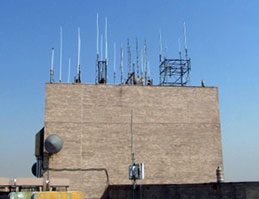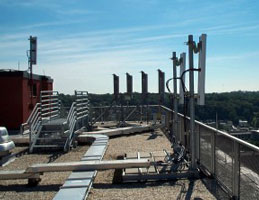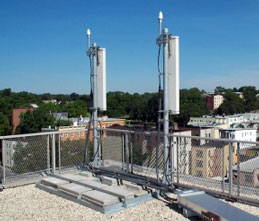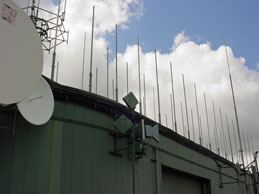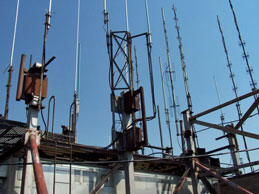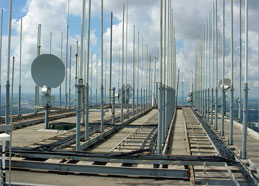Rooftops
Rooftops are very attractive locations for antennas. Unlike a tower, the structure already exists, and licensees can avoid the expense and often the controversy involved in building a new tower. In addition, building owners are often tempted by the steady revenue stream that leasing space for antennas can bring.
Buildings with the right elevation and location are often home to multiple carriers. In addition to the traditional wireless communications carriers—cellular, PCS, and GSM—rooftops are frequently home to a variety of two-way radio services such as fire, police, and emergency services systems and microwave point-to-point communications antennas. Some rooftop sites contain satellite antennas. While the majority of these satellite antennas are receive-only (RO) systems, there are many sites with satellite-uplink antennas, which do transmit energy. FM radio antennas are surprisingly common on rooftops, and there are even some rooftops with television broadcast antennas.
Who Needs Roof Access?
Unlike towers where it is relatively easy to restrict access, it is very difficult to maintain access control to building rooftops. Just think of the personnel who have legitimate reasons to go onto a building rooftop: building maintenance personnel; heating, ventilation, and air conditioning (HVAC) contractors; elevator maintenance and repair personnel; painting contractors; window washers; and the electronic technicians that maintain and install the antenna systems. The personnel who work on the antennas are the only visitors to rooftops that are likely to have any knowledge of RF safety issues.
Controlling Access and Signage
Many people believe that simply adding a sign at the entrance to the roof is all they need to do. Unfortunately, that is not adequate. If there are places on the roof that people can go without using extraordinary means, such as climbing a portable ladder, where they might be exposed to RF field levels above the FCC’s Maximum Permissible Exposure (MPE) limit for General Population/Uncontrolled (public) exposure, the RF safety issue must be addressed. Simply adding a sign at the entrance to the roof does not satisfy the FCC’s requirements that only “fully aware” personnel who are “able to exercise control” over their RF exposure be exposed to RF field levels above the public limit.
The best approach is to make sure that the antennas are installed in such a manner that the rooftop is compliant by design. There will always be areas in front of antennas where the public limits may be exceeded, but if these areas require access via a ladder or some other form of mechanical lift, then the rooftop is reasonably easy to manage. In this case, some simple guidelines can be written. All personnel who visit the rooftop should receive this site-specific information and sign a document that acknowledges that they have received the information and will follow the rules contained within the document.
Get Some Answers for Your Rooftop
For sites that cannot be made completely compliant by design, the next best approach is to identify the problem areas and restrict access to only the areas of the roof where there is a potential RF safety exposure issue, i.e. areas where a person might be exposed to levels above the FCC public limit. A combination of signs and barriers can then be used to restrict access to these areas of the roof, and the site-specific RF safety document should detail the procedures to follow should access be needed. It is much easier to control access to small areas of a roof than to try to limit access to the entire rooftop.
RF Safety Solutions can help you evaluate your rooftop site, often without having to perform on-site measurements. We can also write a simple RF safety control and information document specific to your site.
If you have concerns or questions about RF safety on rooftops, contact us for a no-obligation evaluation of your site.
